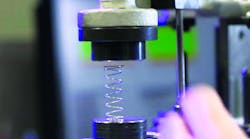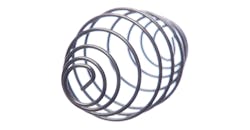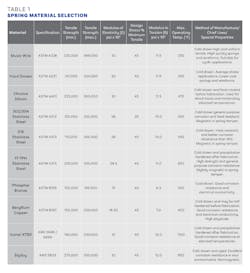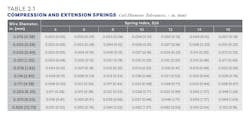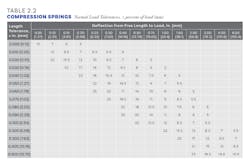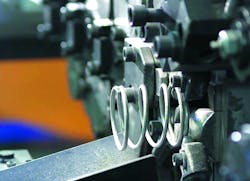When designing helical or compression springs, you’ll confront several challenges and trade-offs, especially when it comes to getting the best possible performance from the wire. You will want to use the material wisely—selecting just the right amount of active wire length and diameter to satisfy essential load requirements while making the design economically and mechanically viable for production.
Wire diameter is an important parameter in the most critical spring design concepts. This article will present some of the most essential considerations engineers need to remember when designing coil springs and describe how wire diameter can factor into those decisions.
Consider Operating Environment When Selecting Wire Material
The spring’s operating environment is going to influence its design as much as anything in the blueprint. Certain materials have properties that make them either critically necessary or prohibitive, depending on where the spring will be used. In many use cases, carbon spring steel or music wire will be sufficient. Other environments will have special material requirements. For example, a spring deployed in a wet environment is likely going to require stainless steel or nickel for their anti-corrosive properties. Stainless steel is also a distinct choice for medical devices, but springs for body-invasive medical applications cannot be made from toxins. Therefore, titanium or Elgiloy may be the better choice. High-heat situations, such as those encountered in the aircraft industry, may require special alloys. Consequently, selecting the spring material based on the operating environment is the first of several important decisions.
Springs used in different environments will dictate the material chosen. Wet environments may require stainless steel, while medical toxic use cases may need titanium or Elgiloy.
From this starting point, the spring designer can think about spring performance requirements and the different trade-offs involved with choosing the material. Fatigue life is another important consideration. Perhaps the spring is required to continuously cycle between two or three points over an infinite period. Or, in a static application, it is required to sit at a specific height or position waiting to provide some energy just once, as is typical inside a drug delivery system.
After these and other determinations, the designer can then decide on the wire size to use along with the corresponding wire diameter. That decision comes down to how much area is available for the spring. Stress is the enemy of a spring, so if a higher volume of wire can fit into the available space when given the same load, the spring will have a higher fatigue life.
Stress and fatigue are important concepts that affect the performance of your spring. There are three other concepts that designers must understand, and each is directly affected by wire diameter.
Commonly used spring wire materials including their characteristics, operating temperatures, main uses, and special properties. The Spring Manufacturers Institute (SMI) Handbook of Spring Design publishes an extensive list of spring materials which includes many special purpose, high-temperature, and non-ferrous alloy wires. Be sure to work with your spring manufacturer to select the optimal spring wire material for your design.
Know Your Spring Index, Spring Rate, and Tolerance
No discussion about spring design would be complete without an overview of spring index, spring rate, and tolerance:
Spring index. The mean diameter of the spring divided by the wire diameter of the spring. It indicates how difficult it is to manufacture and shape the wire, the tolerance of the wire and, therefore, how much the spring will cost to make.
Spring rate. The pounds of force required to compress a spring by one inch. A spring’s strength comes from the volume of wire in the spring, which is determined by wire diameter and the length of the wire. Note: In the formula for spring rate, changes in the wire diameter are exponential to the fourth power.
Tolerance. A permissible range of force per inch from the spring rate that can be applied to the spring’s manufacture. This range is usually ±10% of the spring rate.
Formulae for calculating spring index, spring rate, and spring load and travel.
Manufacturing Considerations
The actual spring index number can have many implications. A spring index between 3 and 20 is considered good because springs within that range will likely be easier and less costly to manufacture, and an index number of 7 has been a traditional rule of thumb because it is an achievable balance of spring strength and manufacturability. Springs can be made with indices outside this range, but that can give rise to potential difficulties.
For example, a large mean diameter versus the wire diameter can yield a large index and a soft spring that cannot hold the desired load. At the low end, a spring index below 3 may add stresses to the tooling, which would complicate manufacturing. To reach an ideal spring index for manufacturing, the designer has to raise or lower the mean diameter of the wire or the actual wire diameter.
However, diameter control in larger-index springs comes with another challenge: recoil. After the spring is wound, the wire immediately expands when the tension is removed. Smaller indices present less recoil, making the tolerance more controllable.
Once again, tolerance is a variable range of ±10% of the spring rate. Since wire diameter factors into the spring rate, it also affects tolerance, which is a percentage of the load—the amount of weight a spring is able to absorb when deflected a given distance. That range (expressed in pounds per inch) increases and decreases along with spring size.
If a spring has a high spring rate, its permissible range of force will also be high. A low spring rate means that the pounds of force that fall into that permissible range will also be small. Therefore, a design with a smaller wire diameter means the spring will be smaller and will also have a smaller load tolerance. Conversely, as the wire diameter increases, the spring is also larger, as well as its load tolerance (as shown in Table 2.1).
The size of the tolerance can affect how a spring is manufactured, thereby impacting production times and costs. Several design variables factor into a spring’s load tolerances, so be sure to work with a spring manufacturer that has the resources to assist you in achieving optimal results, especially if they fall outside ±10% tolerance. And, if your wire diameter is too large, it may not fit into its intended device.
The Spring Manufacturers Institute (SMI) publishes tables giving tolerances on major spring dimensions based on normal manufacturing variations to serve as guides in establishing tolerances, particularly to help estimate whether or not application requirements may affect spring costs. The SMI tables shown here represent coil diameter and normal load tolerances for compression springs (and extension springs where indicated). Consult with your spring manufacturer when making design decisions based on tolerance tables.
Make Sure Your Spring Can Carry Its Load
When setting out to design a spring, you obviously want to know how it will perform under a working load. If the spring rate is too weak, the spring will not deliver the load as required. Too much stress lowers the spring’s fatigue life, causing it to fail sooner. Simply put, the best way to reduce the stress on a spring is to maximize its strength.
Three things to keep in mind when discussing springs are spring index, spring rate, and tolerance.
As mentioned, the wire’s strength comes from the volume of wire in the spring, which is determined by wire diameter and the length of the wire. The higher the volume of wire material given to a spring will enable it to handle a greater load and reduce the stresses on the spring, thereby optimizing the spring’s fatigue life. That can be important in, for example, an automotive spring that may be tasked to endure millions of cycles.
Consider choosing a wire material that has more volume, which reduces the amount of wire in the spring, and avoid delivering more load than necessary. You may even need to add wire to decrease the rate if the spring rate is too high. Normal load tolerances for compression springs are shown in Table 2.2.
Keys to Optimal Spring Design
Many considerations have to be addressed during spring design, but it begins with material selection. Be sure to learn as much as possible about your device’s intended operating environment and the space available for spring installation. Once you select your material, carefully consider how wire diameter and volume can help determine your spring’s load-handling capabilities, tolerances and manufacturability.
Many spring companies provide technical support and excellent customer service, helping you through the design process and ensuring that you have an optimal coil spring design for your application.
Jim Fournier is a product engineer of economy springs at MW Industries.
